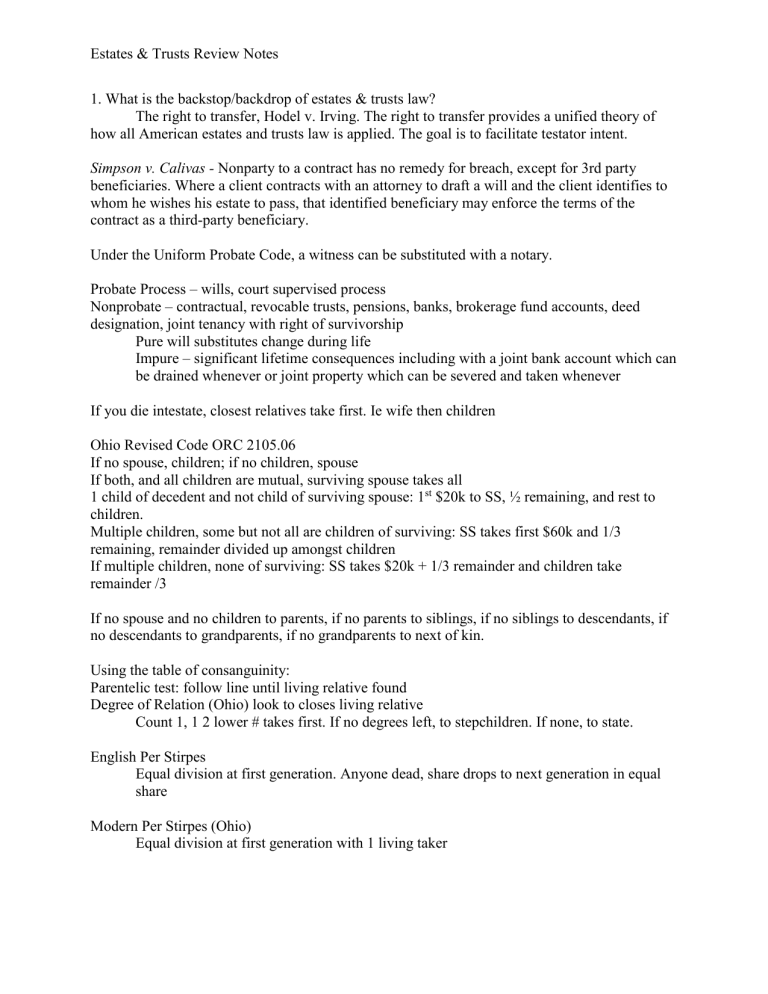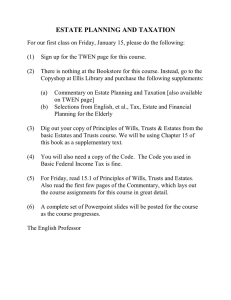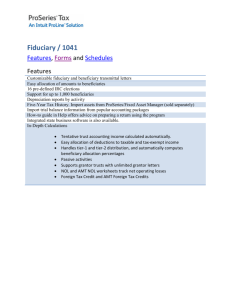
Estates & Trusts Review Notes 1. What is the backstop/backdrop of estates & trusts law? The right to transfer, Hodel v. Irving. The right to transfer provides a unified theory of how all American estates and trusts law is applied. The goal is to facilitate testator intent. Simpson v. Calivas - Nonparty to a contract has no remedy for breach, except for 3rd party beneficiaries. Where a client contracts with an attorney to draft a will and the client identifies to whom he wishes his estate to pass, that identified beneficiary may enforce the terms of the contract as a third-party beneficiary. Under the Uniform Probate Code, a witness can be substituted with a notary. Probate Process – wills, court supervised process Nonprobate – contractual, revocable trusts, pensions, banks, brokerage fund accounts, deed designation, joint tenancy with right of survivorship Pure will substitutes change during life Impure – significant lifetime consequences including with a joint bank account which can be drained whenever or joint property which can be severed and taken whenever If you die intestate, closest relatives take first. Ie wife then children Ohio Revised Code ORC 2105.06 If no spouse, children; if no children, spouse If both, and all children are mutual, surviving spouse takes all 1 child of decedent and not child of surviving spouse: 1st $20k to SS, ½ remaining, and rest to children. Multiple children, some but not all are children of surviving: SS takes first $60k and 1/3 remaining, remainder divided up amongst children If multiple children, none of surviving: SS takes $20k + 1/3 remainder and children take remainder /3 If no spouse and no children to parents, if no parents to siblings, if no siblings to descendants, if no descendants to grandparents, if no grandparents to next of kin. Using the table of consanguinity: Parentelic test: follow line until living relative found Degree of Relation (Ohio) look to closes living relative Count 1, 1 2 lower # takes first. If no degrees left, to stepchildren. If none, to state. English Per Stirpes Equal division at first generation. Anyone dead, share drops to next generation in equal share Modern Per Stirpes (Ohio) Equal division at first generation with 1 living taker Estates & Trusts Review Notes Per Capita at Each Generation Equal division at first generation with at least one living taker. If anyone in that generation is dead, shares don’t drop down. Instead, they are thrown into the hotchpot. Hotchpot = blending of property for purposes of equal division Add shares and divide for next generation. Equally near, equally dear. Every person of same relation = same share. Does not include in-laws or those without descendants, ancestors. Relative to wills can use any of the three or a custom under intestacy or a will. Majority and Ohio = modern per stirpes (if silent) Professional Responsibility Must know the family well, mistakes = complaints Duty Critical 1. Rule of Privity – standing to sue exists if there is privity of contract. Originally only for testators but now for beneficiaries. Exceptions in Ohio: Privity with testator, fraud / bad faith 2. Conflict of Interest – It is normal/ethical, with a waiver of conflict of interest, to represent both spouses. Add a waiver of confidentiality, not just a simple waiver of conflict of interest. Full disclosure to both spouses. No secrets. If there is a conflict of interest, the attorney must drop both clients. Who is a child? Adoptive – Transplant Theory of Adoption – out of old family, can no longer take. Into new family, can take. One exception in Ohio: If the child is adopted by stepparent so long as right of biological parent is not terminated during life, can take from both. Non-Marital/Illegitimate Child Can take from mom. Can also take from father too if paternity is established before his death Posthumous Children – conceived (science) – case law/balancing tests. Massachusetts law. In Ohio, the 300-day rule after death applies. Declare Heirs – one can declare heirs in probate court with two witnesses. This is irrevocable for one year. Adoptions are irrevocable, unless re-adopted or lost custody. There is no adult adoption in Ohio, but there is designated heirship whereby someone can be designated as an heir and receive just like a child. Gratuitous Transfer – cannot force acceptance, 9 months to disclaim. Involuntary Bar to Succession: Slayer Rule: If you intentionally kill another, you cannot inherit from them. Criminally convicted, or civilly by a preponderance of evidence, cannot inherit. Does not bar children or descendants of slayer. Slayer treated as if predeceasing the decedent. Estates & Trusts Review Notes How wills are executed: 1. Writing – on any surface 2. Signature – any mark made with intention to adopt will as one’s own. Not yet including digital 3. Attestation – witness by 2 18+ disinterested witnesses Secondary/side formalities: 1. Subscription: testator and witnesses must sign at bottom/end of will 2. Conscious presence: witnesses must be there to hear even if can’t see (no zoom) Old School Rule: Wills must be executed perfectly. The slightest mistake renders a will wholly invalid / strict compliance or totally invalid Today, after In re Snide ad hoc exceptions are made for common mistakes. Prof. John Langham of Yale argues for harmless error and substantial compliance Must prove, by clear & convincing evidence, that the four functions of the will were satisfied: 1. Ritual/cautionary – legally binding 2. Evidentiary – evidence of intent & right to transfer 3. Protective – free from fraud/duress/undue influence 4. Channeling – through court supervised process of wills If all four functions are met, but not all formalities, substantial compliance will allow the will to be admitted to probate Harmless error – If shown, by clear and convincing evidence that this will was intended to be testator’s last and final will, then it is their will. Dispensing Power – both require clear and convincing evidence. Harmless Error Exceptions in Ohio 1. Testator wrote or caused the writing to be created 2. Testator signed, but no subscription 3. 2 Witnesses were consciously present but did not sign Not all wills require witnessing, however. Holographic wills (not in Ohio) are a type of handwritten will, signed by testator in his handwriting, but not witnessed. Under the 1969, UPC, they are valid if the material signature and provisions are in the testator’s own hand. This includes the dispositive provisions. Non-dispositive provisions can be written by the trustee. In 1922, this changed to material portions and signature allowing comparison for handwritten vs typed wills, but the majority are handwritten. To break a will, there must either be a recovation by subsequent writing (with a separate writing, signature, and attestation by two witnesses), a physical act (tearing up/ripping/obliterating the pages) or by a complete cancellation of the words of the will. Cannot just tear up one page or one paragraph, must tear up the entire will. In Ohio, no physical act will suffice, one must have a subsequent writing. Estates & Trusts Review Notes Doctrine of Integration Any document present and intended to be within the will is within, however because this can be difficult to prove, one should number the pages, or fasten, or staple them in some way so the court knows what should be integrated. Doctrine of Repudiation by Codicil Re-executed by last amendment validly executed to it. Later will controls vis a vis an earlier will. Will 2 wins. If you amend will 1 in year 3, year 1 controls as amended Doctrine of Incorporation by Reference Any page or any document, signed or not into will so long as sufficient evidence of intent to incpororate exists. Identify document intended to include and show document existed at time of will execution (cannot incorporate document by future reference). Clark v. Greenhalsh – will executed in year 1 w document in year 2 amended in year 3. Ill executed in year 3 now includes document from year 2 in year 3 (repudiation by codicil) Doctrine of Ademption – cannot give away what you don’t own Doctrine of Extinction – Identity theory, gone and beneficiary takes nothing Newer Intent Theory – did testator attempt to ademe? Did someone else give away? Court can give equivalent value. Ohio follows a modified intent theory – applies unless given away by specific type of fiduciary: guardian, power of attorney, durable power of attorney If one gives away, intent theory applies. If another gives away, identity theory applies Adepmtion by Satisfaction – Advancement on inheritance Advancements: Intestacy Ademption: Testacy Both reduce if a lifetime gift from parent to child Parent must say in contemporaneous writing “advancement” satisfaction presumed unless stated otherwise. Reduce inheritance by amount of lifetime gift. Advancement calculate into hotchpot Satisfaction – subtract from amount less $ gift Abatement – Leave higher value than net worth Creditors take first then beneficiaries. Abate 1) Residuary, 2) General 3) Together Specific & demonstrative Unless will provides different order, default rule (death tax default too) Capacity Burden of Proof: Will Contestant Must know what you have and must be able to say where you want it to go In re Estate of Breeden – drugged up suicide, wrote will, allowed. Eccentricities do not rob you of capacity. Estates & Trusts Review Notes Undue Influence Step 1. Burden of proof is on the contestant, can shift to the proponent (undue influence) Confidential Relationship: caregiver, attorney-client, nurse-patient, power of attorney, mixed family Suspicious circumstances: large, unnatural bequeaths, secret will, will made in haste, drastic change in estate plan, drastic change in relationship of testator after meeting accused undue influencer. Ohio only requires CI to shift burden, disprove 1, if not shifted, prove all 4 Step 2. Prove or Disprove elements of undue influence 1. Susceptible testator? Under care, Alzheimer’s etc 2. Opportunity to influence? Can I talk to? 3. Attempted or actual exertion of undue influence? (hardest to prove-indirect evidence) 4. Effect on the will Fraud in the Execution – Deliberate misrepresentation about the contents of the will being signed Fraud in the Inducement – Any deliberate misrepresentation to induce testator to leave to someone other than those who they would normally leave to Duress – Undue influence on steroids with force or threat of force Tortious Interference with an Expectancy – thru no fault of your own The ability to bring probate suits is exhausted Must show expectancy Interference – affirmative misconduct, fraud, duress, undue influence Causation Damages Mistake Plain Meaning Rule: Follow the plain unambiguous meaning of the words of the will Ambiguities can be resolved Patent: Clear from face of will (conflicting case law in Ohio) Latent: Clear with reference to extrinsic evidence 1. Equivocation – 2 persons/things fit perfectly 2. No person/thing perfectly fits, but multiple partially fit If the beneficiary dies before the testator or bequest lapses/fails, in general, specific, demonstrative, general bequests lapse or fail and fall under the residue of the estate. When residuary fails/collapses, it depends on the no residue-of-a-residue rule No Residue of a Residue Rule States that follow: fall into intestacy Ohio abolished, falls back into residue if possible. If there is another residuary beneficiary eligible to take. If no others, then failed residue falls into intestacy following default rules of lapse. Estates & Trusts Review Notes Anti-Lapse Statute: 1. Beneficiary pre-deceases testator 2. Beneficiary had sufficiently close relation to testator – relative at all (Ohio grandparents and their descendants, and stepchildren) 3. Beneficiary has descendants (substitute in place) 4. Will does not override anti-lapse statute (merely a default rule) Beneficiary must die before a testator (dead don’t take) In Ohio, words of survivorship are sufficient to override anti-lapse statute. “If he survives me.” If property changes, division must change. Stock split, dividend hike. Trusts are relationships not entities. They cannot sue or be sued. Instead one must sue the trustee or be sued by the trustee The relationship between the grantor/settlor/creator of trust/one who endows it with trust property. Managed by a trustee who holds all legal title and has all power over it that an unmarried feesimple absolute owner would for the benefit of the beneficiaries who hold equitable title over said property. Enforced vis-à-vis fiduciary obligations where beneficiary can sue for breach of fiduciary duty Fiduciary Duties Loyalty Prudence Impartiality Undivided loyalty to the beneficiaries Sole benefit rule: manage for sole benefit of the beneficiaries. Self-dealing of any kind is an automatic breach and is prohibited unless waived by beneficiary or grantor. No Further Inquiry Rule: Once self-dealing is established, no further inquiryautomatic breach. Conflict of Interest: Hartman v. Hardle, In re Gleeson’s Will Dealing directly with oneself: In Re Rothko executor & purchaser Fiduciary obligation is the same for executors/administrators/trustees Can breach if aware others have conflict Duty of Prudence – objective standard of care. Act as a reasonably prudent person would. Estates & Trusts Review Notes Duty of Prudent Investment: balance risk & return Consider portfolio as a whole, avoid uncompensated risk at all cost. Diversification away from industry and firm risk. Failure to diversify is a per se breach. Duty to Administer Trust according to the law and its trust instrument. Cappy Case: Trustee did not follow by incorrectly distributing principal for Mr. Cappy. Duty of Impartiality – follow intent of grantor in treating beneficiary Trust Creation Intent – property held by one for benefit of another Trust Property – must have at least a peppercorn Ascertainable Beneficiaries Not required as a writing, writing only required for testamentary or real property, can be oral. Can be created by deed or declaration. Deed transferred by grantordelivery Delivery: physical (actually give), constructive (means), symbolic (memo or model) Delivery is not required for trust by declaration Must use grantor. Grantor must be trustee, no need for delivery Planning for incapacity Power of attorney expires on lac of capacity Durable power of attorney expires on death, but survives incapacity Trust survives both Agent-Principle Relationship for Healthcare Instructional directives ie DNR Proxy Directives Hybrid – instructions with proxy to decide Biggest limit on testamentary freedom: not estate tax but right of surviving spouse, which differs in community vs separate property states. In community property states, spouse already owns ½ because income earned during the marriage is 50% earned by yourself and 50% by your selfless agent for the principal of your spouse who cannot be disinherited of half. In separate property states, of which 2/3 states in the US, including Ohio, are, forced share. Curtesy right – 100% right to life estate in the land of the wife for the husband, vests upon birth of first child Dower right – 1/3 life estate in land from husband to wife that vests upon marriage Estates & Trusts Review Notes Ohio has modified dower right regardless of gender. All spouses have 1/3 life estate in real property owned during the marriage, but not owned upon death. Forced share 1/3 of ½ in Ohio if less than 2 children and 1/3 to children. If 2 or more children, 1/3 or ½ of probate estate. Most states, not Ohio, apply to total probate and non-probate estate. No forced share for children anywhere except Louisiana. Protection for unintentionally omitted children. If forgotten, entitled to modified intestate share of non-spousal estate. Share in estate minus spouses share. Right of beneficiaries & creditors run conterminously. Beneficiary can take so too can the creditor. Neither can reach discretionary trusts. Nothing to beneficiary, creditor cannot force distribution either. If beneficiary is entitled to a distribution and can force, so too can the creditor. Hamilton Order – order whereby if trustee chooses to make a distribution, must give to creditor first. All discretionary or mandatory, all spendthrift or not, all revocable or irrevocable Trusts can be modified or terminated in several ways Private trust – background rule: all beneficiaries and grantor agree Claflin Doctrine: beneficiaries consent & proposed modification does not conflict with material purpose of the trust. Do not need unanimity so long as interests of dissenting beneficiaries are sufficiently protected. Equitable Deviation – unforeseen circumstances & proposed modification/termination furthers trust purpose Charitable trust modified as close as possible to purpose of old one Private Trust Ascertainable beneficiaries Enforced by beneficiaries Rule against perpetuities Charity Trusts Charitable Purpose Enforced by State Attorney General Exempt from RAP


